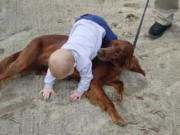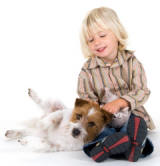
Click on
Library Icon
to learn more
|
Prevention is the key!
Prevention is always better than
treatment. The way to prevent a problem dog around
children is to raise a dog around children who are
themselves trained in how to properly relate with a
dog. The child's "proper relating" to the dog
consists of two parts:
of two parts:
First,
there are things that
children should not do to
dogs.
This includes most of the
things that children tend to
do with dogs, like hugging
before they really know the
dog, spanking, hitting the
dog with things, stealing a
dog toy, chasing, pulling on
ears, tail or hair.
Second,
children need to be taught
to gently pet the dog, call
the dog to them, ask the dog
to "sit" and, THEN take a
cookie (i.e., food treat).
They can play tag, as long
as only paws, not teeth,
touch the child. They can
give a body massage under
supervision. They can play
hide and seek or throw a
ball. If a dog is raised
with children from an early
age with no bad experiences,
he or she will very likely
grow up enjoying the company
of and loving children.
|
A good rule of thumb is for
the child to be introduced
to the dog by calling the
dog to the child. If the dog
will not come to the child,
the child should not go to
the dog. |
If the child
approaches the dog, the dog may
interpret this as invading the
dog's territory as a challenge,
and/or threat. If the dog comes
to the child, have the child act
relaxed, offer a hand to be
sniffed, and speak is a calm,
happy tone. If possible, have
the child ask the dog to "sit"
and then give the dog a food
treat. Demonstrate how to do
this for the child. The adult
needs to stand behind the child
so that the dog sees the adult
as the child's back-up person.
Canine Critical
Socialization Period
Dogs have a critical
socialization period between two and four months of
age when they are hard-wired to learn about social
experiences with other beings. If dogs do not have a
"kid experience" during this time, they have a
greater tendency to perceive children as "outside of
their social group" and, therefore, not to be
trusted.
There is a greater risk of dogs
over six months of age, who have not been exposed to
children, to be more fearful, distrustful, and
sometimes even aggressive towards children later in
life. Perhaps a toddlers frequent c hanges in balance
(misinterpreted as threat postures) or their shrill
shrieks (misinterpreted as prey sounds) are to
blame. hanges in balance
(misinterpreted as threat postures) or their shrill
shrieks (misinterpreted as prey sounds) are to
blame.
At
Home
In the home
situation, the dog should learn
that he or she should defer to
all people, including children.
This means the child can touch
the dog and give him or her
instructions, and the dog's job is
to comply. As long as the dog
can get along with children and
realize that children are a
giver of good treats and gentle
petting, then the relationship
will blossom over time.
|